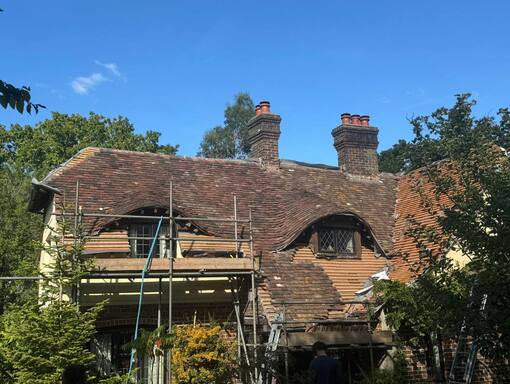Introduction
Many homeowners assume that the only time to replace a roof is when it reaches a certain age — typically 20 to 30 years, depending on materials. But in reality, the lifespan of a roof tells only part of the story. A much younger roof can still require replacement if it suffers from structural damage, poor workmanship, or ongoing performance issues.
At Griston Roofing Services, we’ve worked with numerous homeowners across Griston, Norfolk, who were surprised to discover that their roof needed replacing well before it hit retirement age. In this blog, we’ll explore the many factors that could justify replacing your roof — even if it still seems relatively young.
Repeated Leaks or Water Ingress
If your roof has experienced multiple leaks over the past few years, it’s often a warning sign that larger issues are at play. You might have patched up small areas here and there, but that approach doesn’t always resolve underlying failures.
Signs it’s more than a small leak:
- Water staining on ceilings in multiple rooms
- Damp patches appearing after light rain
- Mould or mildew in the attic space
Continual leaking compromises the roof structure and insulation. At some point, repeated patching becomes more costly and less effective than a full roof replacement.
Poor Installation Quality
It’s possible to have a relatively new roof that performs poorly — simply due to improper installation. We frequently encounter roofs installed with shortcuts or subpar materials, which reduces their effective lifespan.
Warning signs of bad installation:
- Uneven tile alignment
- Poor flashing work around chimneys and valleys
- Loose ridge or verge tiles
Even if your roof is just 5 or 10 years old, it may already be showing failure signs if it wasn’t installed correctly the first time. Replacing it properly can save you ongoing frustration and repair costs.
Structural Damage After Storms
Norfolk weather may not bring hurricanes, but storms, strong winds, and falling debris can still cause significant damage. You might notice missing tiles, bent guttering, or cracked ridge lines — all of which compromise the roof’s ability to protect your home.
Damage can include:
- Uplifted tiles from high winds
- Impact cracks from tree limbs or debris
- Displaced underlay or insulation layers
Even if the damage seems localised, it often affects the integrity of the whole roof. Replacing it may be the best long-term option.
Ongoing Maintenance Becomes Unmanageable
Older roofs or roofs with persistent issues may start demanding more and more attention. If you find yourself booking repairs every year — or even more frequently — it’s time to evaluate the value of starting fresh.
Frequent maintenance red flags:
- Constant need to re-fix tiles or flashing
- Guttering repeatedly clogging due to roof debris
- Persistent damp, even after repairs
In such cases, a new roof isn’t just a repair — it’s a way to reclaim your peace of mind and reduce ongoing expenses.
Energy Efficiency Is Compromised
An old or poorly performing roof affects more than just weather protection. It also plays a vital role in your home’s energy efficiency. If you’ve noticed heating bills creeping up or that your loft feels unusually draughty, the roof may be to blame.
A poorly performing roof may:
- Let warm air escape in winter
- Trap heat in the summer
- Allow cold air to seep through gaps or poor insulation
Replacing your roof gives you the opportunity to upgrade to modern insulation methods and materials, making your home more efficient and comfortable.
Signs of Sagging or Structural Instability
If your roof appears to dip or sag in certain areas, it’s more than a cosmetic concern. Structural movement could indicate that the internal supports — rafters or trusses — are failing due to moisture damage, rot, or age.
Sagging roof issues may be caused by:
- Waterlogged timbers
- Previous repairs done poorly
- Insect or fungal damage to support beams
This type of problem needs urgent attention, and often the best solution is to replace the roof entirely to restore structural integrity.
Roof Doesn’t Suit Modern Requirements
In some cases, homeowners choose to replace a roof not because it’s broken — but because it’s no longer fit for modern living. If you’re adding solar panels, converting your loft, or simply want a more visually appealing exterior, a roof replacement may be the most practical route.
Modern upgrades could include:
- Better ventilation for loft conversions
- Slate or tile alternatives for improved kerb appeal
- Structural changes to accommodate skylights or dormers
At Griston Roofing Services, we frequently work on properties in Griston, Norfolk, where functional upgrades lead to aesthetic and efficiency gains.
Conclusion
Roof replacement isn’t always a matter of age. Whether it’s structural issues, poor installation, persistent leaks, or simply a roof that doesn’t meet your home’s current needs, there are several compelling reasons to replace your roof — even if it’s technically still within its “expected” lifespan.
If you suspect your roof may be underperforming or unsafe, it’s worth having a professional assess it properly. The team at Griston Roofing Services is here to help homeowners across Griston, Norfolk make informed, proactive choices about their roofing needs — before minor issues become major ones.
Call us on: 01603 249 398
Click here to find out more about Griston Roofing Services
Click here to complete our contact form and see how we can help with your roofing needs.
